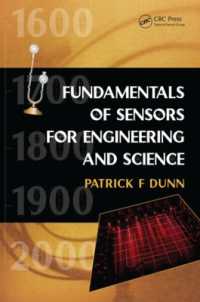- ホーム
- > 洋書
- > 英文書
- > Science / Mathematics
Full Description
The quest for many-body techniques and approximations to describe the essential physics of strongly interacting systems with many degrees of freedom is one of the central themes of contemporary nuclear physics. The three articles in this volume describe advances in this quest in three dif ferent areas of nuclear many-body physics: multi quark degrees of freedom in nucleon-nucleon interactions and light nuclei, multinucleon clusters in many-nucleon wave functions and reactions, and the nuclear-shell model. In each case the common issues arise of identifying the relevant degrees of freedom, truncating those that are inessential, formulating tractable approximations, and judiciously invoking phenomenology when it is not possible to proceed from first principles. Indeed, the parallels between the different applications are often striking, as in the case of the similarities in the treatment of clusters of quarks in nucleon-nucleon interactions and clusters of nucleons in nuclear reactions, and the central role of the resonating group approximation in treating both. Despite two decades of effort since the experimental discovery of quarks in nucleons, we are still far from a derivation of nucleon structure and nucleon-nucleon interactions directly from quantum chromodynamics.
Contents
1 MULTIQUARK SYSTEMS IN HADRONIC PHYSICS.- 1. Introduction.- 2. Multiquark States and the P Matrix.- 3. The Quark Optical Potential Method.- 4. The NN Potential in the QCB Model.- 5. Nucleon-Nucleon Scattering.- 6. The Realistic QCB Potential and the Deuteron Properties.- 7. Meson-Meson and Meson-Nucleon Scattering.- 8. Few-Nucleon Systems in the QCB Method.- 9. Conclusions.- 2 THE THIRD GENERATION OF NUCLEAR PHYSICS WITH THE MICROSCOPIC CLUSTER MODEL.- 1. Introduction.- 2. The Resonating Group Method.- 3. Classical Applications.- 4. Astrophysical Applications.- 5. A Valuable Tool for Many Actual Cases.- 6. Summary and Outlook.- THE FERMION DYNAMICAL SYMMETRY MODEL.- 1. Introduction.- 2. The Fermion Dynamical Symmetry Model.- 3. Dynamical Symmetry Limits and Comparison with the IBM.- 4. The Large Particle Number Limit.- 5. Quantitative Applications.- 6. The Dynamical Pauli Effect.- 7. Microscopic Particle-Rotor Model.- 8. The FDSM and Superdeformation.- 9. Summary.






